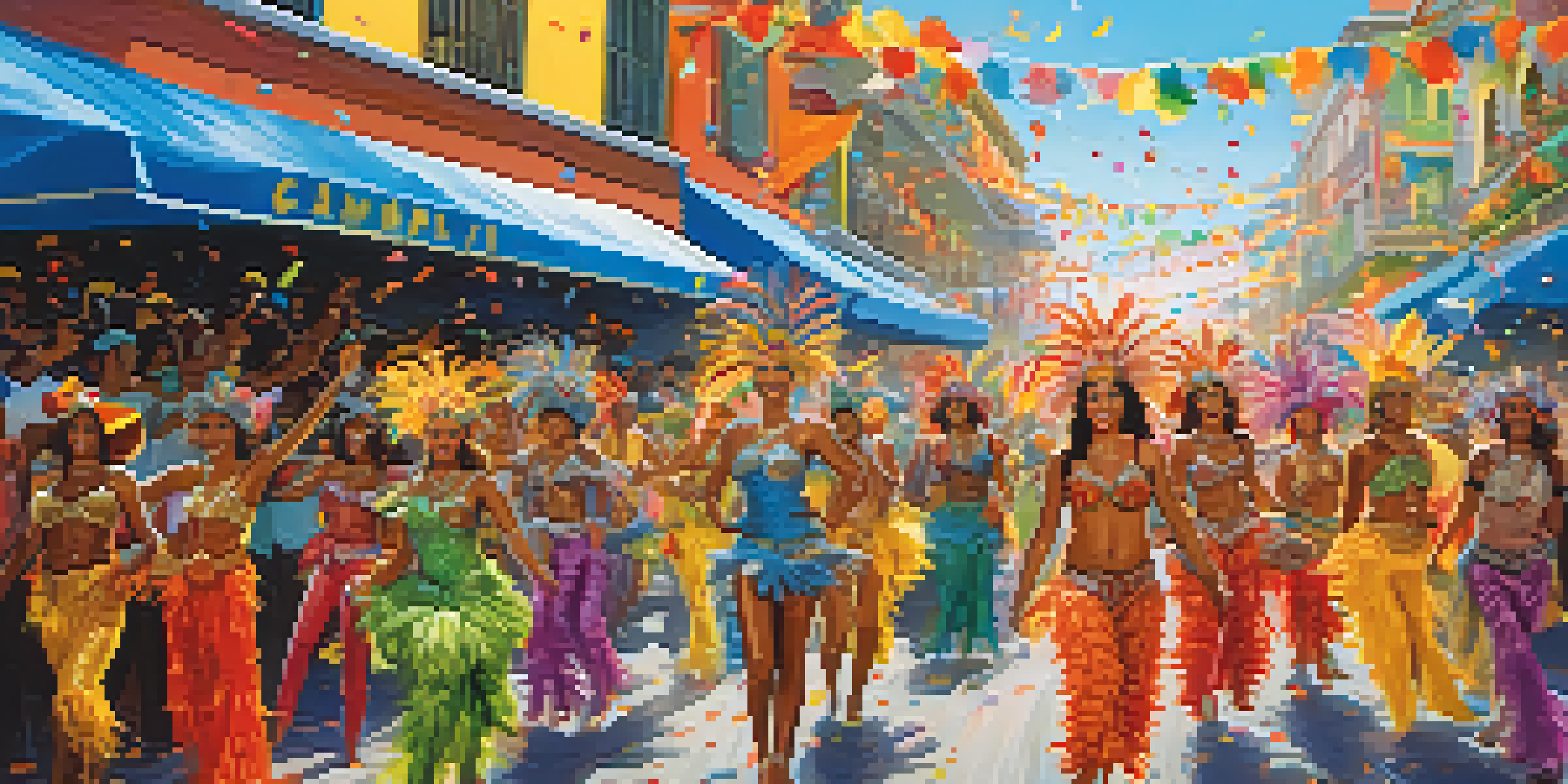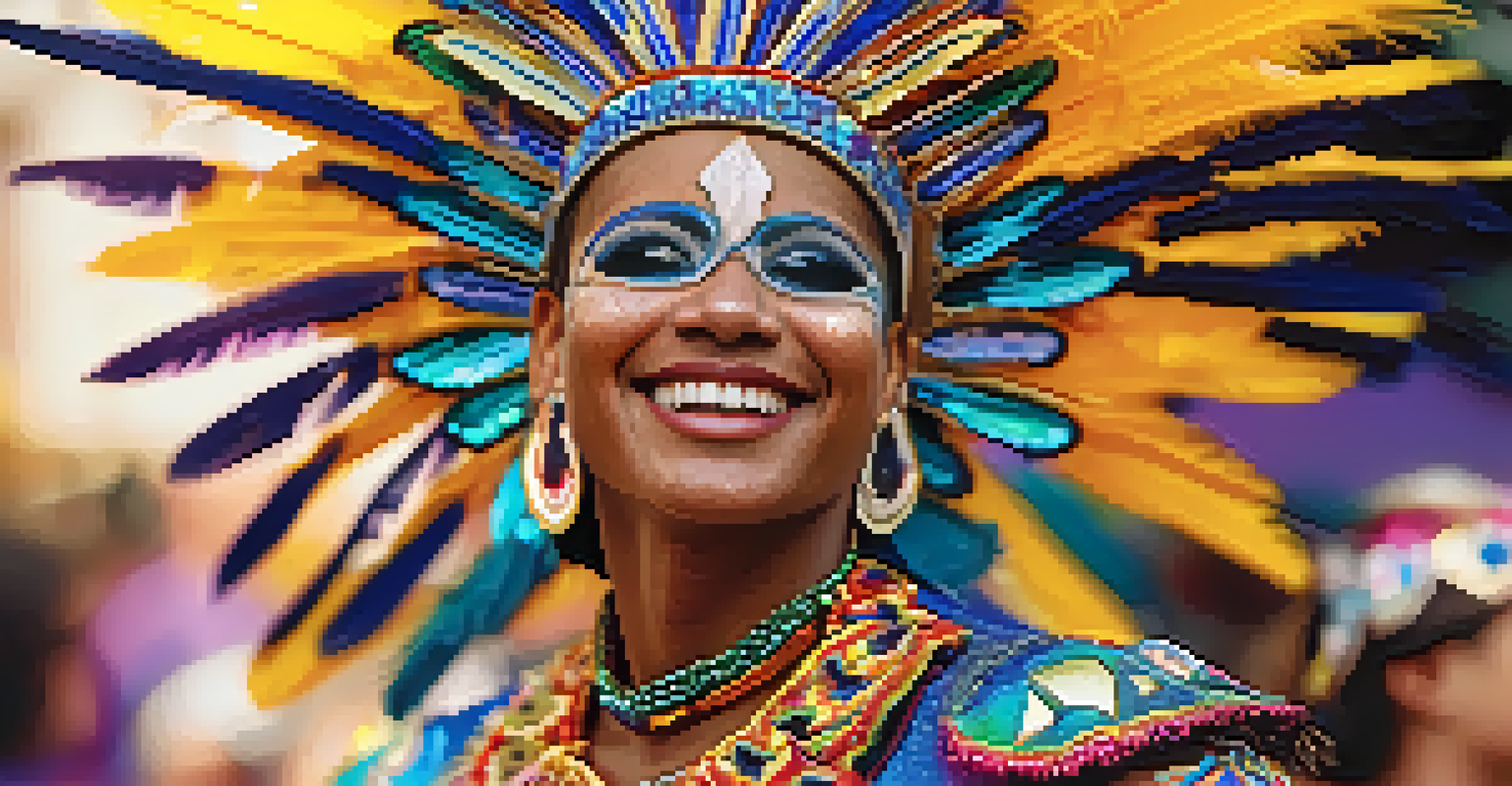Carnaval: A Fusion of Lights, Music, and Brazilian Culture

Carnaval Origins: A Journey Through Time
Carnaval has deep roots in Brazil's history, blending African, Portuguese, and Indigenous influences. These diverse cultural elements come together to create a unique celebration that reflects the country's rich heritage. The festival's origins can be traced back to European Catholic traditions, which were adapted over time to suit the local context.
Carnaval is a celebration of life, a time when we come together to dance, sing, and embrace our cultural roots.
As the festival evolved, it became a platform for social expression, where communities could showcase their identities and traditions. The vibrant parades and lively music illustrate how Carnaval serves as a voice for the often marginalized communities in Brazil. This fusion of cultures is what makes Carnaval not just a party, but a significant cultural event.
Today, Carnaval is celebrated in various forms across the country, with each region adding its own flair. From the spectacular samba schools in Rio de Janeiro to the lively blocos in Salvador, each celebration offers a glimpse into the local culture. It’s a time when everyone, regardless of background, comes together to revel in the joy of life.
The Heartbeat of Carnaval: Music and Dance
At the core of Carnaval lies the infectious rhythm of music and dance that captivates participants and onlookers alike. Samba, the most iconic genre associated with the festival, is characterized by its lively beats and energetic movements. It's not just music; it's a celebration of life that invites everyone to join in the fun.

Dance is equally important during Carnaval, with performers donning elaborate costumes that reflect the themes of their samba schools. These vivid outfits, adorned with feathers and sequins, transform the streets into a kaleidoscope of colors. The connection between dance and culture is palpable, as each step tells a story of tradition and celebration.
Carnaval's Cultural Roots
Carnaval blends African, Portuguese, and Indigenous influences, creating a vibrant celebration that reflects Brazil's rich heritage.
Moreover, the music of Carnaval goes beyond samba. Genres like axé, frevo, and maracatu also play significant roles, each adding its unique flavor to the festivities. This diversity in music creates a rich tapestry of sounds that encourages people to dance freely, fostering a sense of community and belonging.
The Role of Samba Schools in Carnaval
Samba schools are the backbone of Carnaval, meticulously preparing year-round for the grand parades. These organizations are more than just dance troupes; they are cultural institutions that preserve and promote Brazilian traditions. Each school has its own unique identity, deeply rooted in the community it represents.
In every rhythm of samba, there is a heartbeat of the community that brings us all together.
During Carnaval, samba schools compete in elaborate parades, showcasing their themes through dance, music, and vibrant floats. This competition is intense and draws thousands of spectators, all eager to witness the creativity and talent on display. Winning is a matter of pride, not just for the school, but for the entire community.
The preparation for these performances involves countless hours of rehearsals and community involvement. It’s a labor of love that brings people together, fostering a sense of unity and pride. From crafting costumes to perfecting dance routines, samba schools embody the spirit of Carnaval, making it a truly collective experience.
Colorful Costumes: The Art of Carnaval Fashion
Costumes are one of the most striking aspects of Carnaval, showcasing the creativity and artistry of Brazilian culture. Each outfit is carefully designed to reflect the themes chosen by samba schools, often inspired by mythology, nature, or local history. The intricate details and vibrant colors transform participants into living works of art.
The process of creating these costumes involves a collaborative effort among designers, seamstresses, and community members. Many costumes are handmade, emphasizing the importance of craftsmanship and tradition. Wearing these elaborate outfits during Carnaval is not just about aesthetics; it's a way of honoring one's culture and heritage.
Samba Schools' Community Role
Samba schools are cultural institutions that prepare year-round for Carnaval, showcasing their unique identities through elaborate parades.
Furthermore, the costume competition adds another layer of excitement to the festivities. Spectators eagerly anticipate the grand reveal of each school's designs, making it a highlight of the parades. Ultimately, these colorful displays not only enhance the visual spectacle of Carnaval but also tell stories of resilience and celebration.
Carnaval and the Spirit of Community
Carnaval is more than just a festival; it is a celebration of community spirit. People from all walks of life come together to participate, whether by joining a samba school, attending street parties, or simply enjoying the music. This sense of togetherness creates a warm and inviting atmosphere that is one of the festival's most cherished aspects.
The blocos, or street parties, exemplify this communal vibe, as they invite everyone to dance, sing, and celebrate together. These informal gatherings often feature local musicians and promote a sense of belonging, allowing neighborhoods to showcase their unique traditions. It’s a beautiful reminder of how music and dance can break down barriers and unite people.
Moreover, Carnaval serves as an opportunity for social commentary, where communities can express their views on various issues. Through satirical floats and performances, participants use humor and creativity to address political and social realities. This blend of celebration and activism reinforces the idea that Carnaval is not just about fun, but also about community empowerment.
Global Influence: Carnaval Beyond Brazil
The spirit of Carnaval has transcended Brazil's borders, inspiring celebrations around the world. Cities like New Orleans, Venice, and Trinidad have adopted elements of Carnaval, each infusing their local culture into the festivities. This global influence highlights how the essence of Carnaval resonates universally, promoting joy and togetherness.
In these international celebrations, you can see the similarities in music, dance, and vibrant costumes that echo the Brazilian festival. However, each location also adds its own unique twist, resulting in a rich tapestry of cultural expression. It's fascinating to see how Carnaval has become a symbol of unity and celebration across different cultures.
Carnaval's Global Influence
The spirit of Carnaval has inspired celebrations worldwide, promoting joy and togetherness while highlighting cultural exchange.
This global reach also opens doors for cultural exchange, where people from various backgrounds come together to learn about each other's traditions. As Carnaval spreads, it brings with it the values of community, joy, and resilience, reminding us of our shared humanity. Ultimately, it’s a testament to the power of celebration in connecting people worldwide.
Experiencing Carnaval: Tips for Visitors
If you're planning to experience Carnaval in Brazil, preparation is key to fully enjoying the festivities. First, research the different cities and their unique celebrations, as each region offers something special. Whether you choose Rio de Janeiro, Salvador, or Recife, understanding the local culture will enhance your experience.
Dress comfortably and embrace the spirit of Carnaval by wearing colorful outfits or accessories. Many participants opt for bright clothing, feathers, or even glitter to embody the festival's vibrant energy. Don't forget to stay hydrated and take breaks, as the festivities can be exhilarating yet exhausting.

Lastly, immerse yourself in the culture by participating in various events, from samba classes to street parties. Engaging with locals will enrich your experience, allowing you to understand the heart of Carnaval. Remember, it's all about celebrating life, so let loose, dance, and create unforgettable memories!